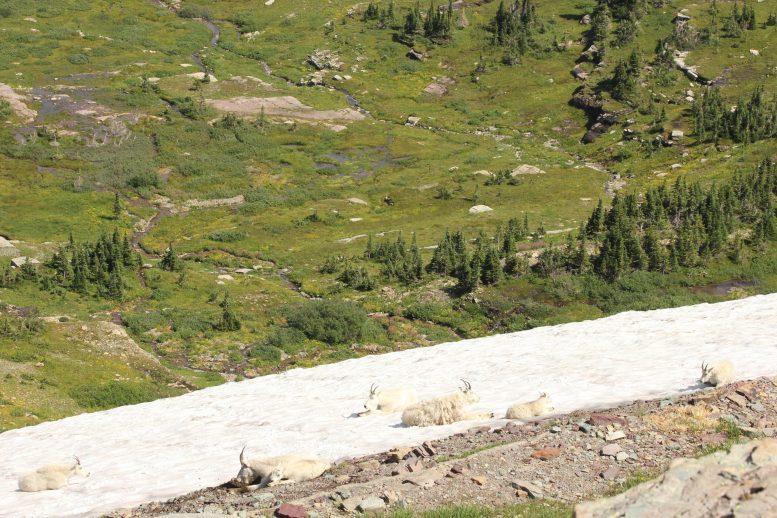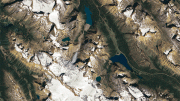
Glacier National Park’s iconic mountain goats seek out vanishing snow patches where they cool and reduce their respiration. Credit: Wesley Sarmento – University of Montana
Glacier National Park’s iconic mountain goats seek out vanishing snow patches where they cool and reduce their respiration.
A new study in the journal PLOS ONE says Glacier National Park’s iconic mountain goats are in dire need of air conditioning.
Glacier National Park has already lost some 75% of its glaciers and many snow patches are rapidly dwindling.
Researchers from the University of Montana, Glacier National Park, and Wildlife Conservation Society (WCS) found that mountain goats (Oreamnos americanus) in Glacier National Park seek out patches of snow in the summertime to reduce heat stress. When they do, breathing rates went down, a behavioral strategy that results in less energy expended.
The trouble is Glacier has already lost some 75% of its glaciers and many snow patches are rapidly dwindling. The park had over 100 glaciers when it was established in 1910. In 2015, only a couple dozen met the size criteria to be considered active glaciers.
The study’s authors, Wesley Sarmento of the University of Montana, Mark Biel of Glacier National Park, and WCS Senior Scientist, Joel Berger, have studied mountain goats in the field since 2013 to better understand thermal environments and their changes on this cold-adapted species in Glacier.
To understand stressors to goats and ways in which they combat heat, the scientists performed observations of animals on and off ice patches on hot summer afternoons, and days with and without wind. To avoid higher temperatures, the goats sought snow patches for resting, and when they found them, breathing rates were reduced by as much as 15 percent.
“10,000 years ago when the North American climate was cooler there were mountain goats in Grand Canyon, but certainly increasing temperatures and drier weather ultimately contributed to their extinction in that area.” — Wesley Sarmento
The authors note that while people seek shade or air conditioning to stabilize their metabolic rates and animals like coyotes or marmots seek dens, mountain goats in the shade-less environs above treeline have less opportunity to reduce exposure to rising temperature. Goats that were observed resting in shade did not have significant reductions in respirations.
“10,000 years ago when the North American climate was cooler there were mountain goats in Grand Canyon, but certainly increasing temperatures and drier weather ultimately contributed to their extinction in that area,” says Sarmento.
Says Biel: “This work is important to shed light on the impacts of a changing climate on these iconic animals and their habitat. How certain species may adapt as the changes continue is critical in understanding their persistence on the landscape into the future.”
Like people from Europe to the America’s and far beyond, high temperatures cause stress and death. In 2019, more than 1,000 people died from heat exposure in France and Spain.
Berger, also the Barbara-Cox Chair of Wildlife Conservation professor at Colorado State University draws analogies beyond alpine animals. “Just as people are feeling the heat of a warming planet with thousands and thousands struggling during summer without natural cooling systems, we’re seeing very clearly that what happens to people is also happening to animals -we’re all in this together.”
The authors say that climate change will affect mountain goats in other areas including in Alaska’s coastal mountains, where summer habitat is expected to shrink up to 86 percent in the next 70 years due to factors such as forest encroachment which in turn will fragment habitat, decrease food availability, and reduce predator detection.
Reference: “Seeking snow and breathing hard – Behavioral tactics in high elevation mammals to combat warming temperatures” by Wesley Sarmento, Mark Biel and Joel Berger, 11 December 2019, PLOS ONE.
DOI: 10.1371/journal.pone.0225456









Many disciplines do not train their practitioners in the Method of Multiple Working Hypotheses (T. C. Chamberlain). In that spirit, I might offer the idea that these animals, being white, are less visible to potential predators, and realizing that, feel more relaxed. Also, Caribou are known to seek out patches of snow in the Summer, to get away from mosquitoes and black flies. Being less bothered by biting insects, one would expect their respiration to decrease.
Were they just seeking a cooler environs, they could move to higher elevations, being adapted to navigating rocky, high terrain. Also, they could seek out shade on north slopes, which commonly have snow patches. The fact that they are lying in bright sunlight reminds me of how my cat seeks out sun in which to luxuriate. Therefore, I favor my suggestions for them lying on the snow, over the claim that they are trying to cool off.
But, either way, the decline of snow and ice since the end of the Little Ice Age will require them to adapt, which is not out of the question. After all, big horn sheep were once common in the Mojave Desert, before they were decimated by disease introduced by domestic sheep.
When I read articles like this, blaming a 1 deg C temperature change in 100 years for all the evil in the world, I’m reminded of the old joke about the handyman who only owns a hammer. Thus, the solution to all problems appear to require nails.
The actual research article states, “Data loggers on snow recorded an average temperature of 9.95° C (± 0.11 S.E.), and in the forest shade temperature was 10.61° C (± 0.54 S.E.), with snow being significantly colder than shade …” That means the snow areas had a 34% chance of being as warm as 10.06° C, and the forest shade had a 34% chance of being as cool as 10.07° C! I don’t see that as being “significantly colder.” I doubt that the goats can tell a difference of 0.66° C, and certainly not a difference of 0.01° C!
They apparently used standard error, rather than the more common standard deviation to estimate their uncertainty. I didn’t wade through all the detail to see if SE was rigorously justified. If not, then the overlap between temperatures would have made the difference in mean values not statistically significant. I’m sure that the goats don’t worry about statistical significance.